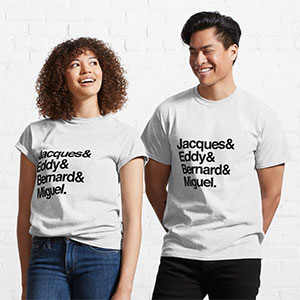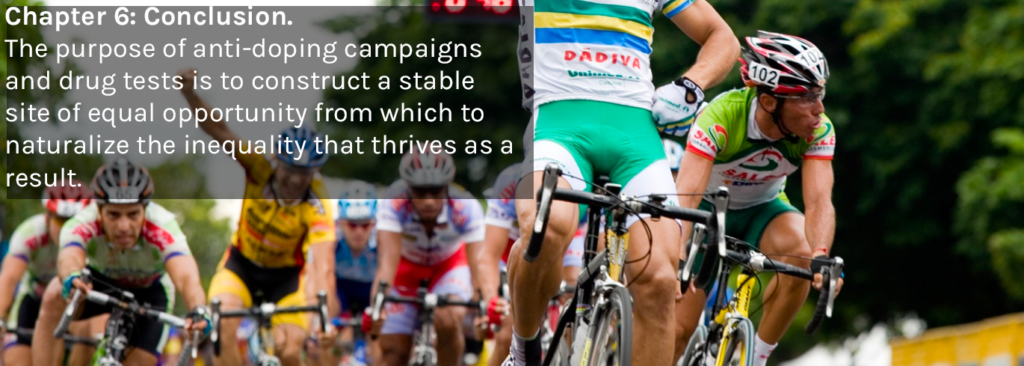Part 6: Conclusion (& Bibliography). The case study of erythropoietin in the Tour de France is intriguing precisely because it acts in ways not fully explored by feminist critique, yet it nevertheless continues to reify the perceived “natural” boundaries upon which gender- and race-based oppressions make their foundations.
Introduction | Background: Drug Testing and Gender Segregation | Case Study: The Transformation of the Natural Body in Cycling’s Epo Era | “Natural” is Discourse | The Discourses Surrounding Banned Performance-enhancing Techniques Perpetuate Gendered and Raced Narratives of Natural Difference | Conclusion | Bibliography
Conclusion
The case study of erythropoietin in the Tour de France is intriguing precisely because it acts in ways not fully explored by feminist critique, yet it nevertheless continues to reify the perceived “natural” boundaries upon which gender- and race-based oppressions make their foundations. Cycling’s evolving relationship with performance-enhancing drugs serves as a framing lens for this study, which intends to begin the process of filling a gap in how the academy understands the narratives surrounding contemporary medicalized sports cheating as a continuation of the gendering processes that began with gender verification and androgen tests.
Sports intend to produce and render visible purported natural difference through competition. The gender segregation in sports is one such realm in which assumptions of natural difference spill into the socialized construction and categorization of sexually dimorphic bodies. This segregation is predicated on two factors: 1) that there are two types of naturally different bodies that should be grouped along a binary opposition determined by genitalia; and 2) that male athletic ability surpasses female athletic ability to such an extent that competition between these two bodily categories is impossible or unfair. The nature or purpose of sexual segregation, then, is to uphold the concept of fairness from which inequality can be expressed in sporting terms. This, too, is the purpose of anti-doping campaigns and drug tests: to construct a stable site of equal opportunity from which to naturalize the inequality that thrives as a result.
In this sense, ideas of illicit performance enhancements contribute to concepts of the natural. That the natural is a discursive effect inscribed with rich social meanings, rather than simply an objective truth that governs human existence, in turn means that the disruption of these narratives is a disruption of the complex positionalities that become naturalized in the body. Certain performance enhancements are banned because they act too much in altering the body, undermining the equality of opportunity that allows sporting participation to render natural difference visible. This places social bodily norms as an extension of natural, and presumes that both must be preserved.
Bibliography
Andreasson, J., 2015. Reconceptualising the Gender of Fitness Doping: Performing and Negotiating Masculinity through Drug-Use Practices. social sciences, 4(3), pp.546-562.
Bernstein, Robin. 2009. Dances with things: Material culture and the performance of race. Social Text 27(4): 67-94.
Brookes, R., 2002. Representing sport. Oxford University Press.
Butler. J., 1987. Variations on Sex and Gender: Beauvoir, Wiffit, Foucault in Butler, J. and Salih, S., 2004. The Judith Butler Reader.
Butler. J., 1993. The lesbian phallus and the morphological imaginary in Butler, J. and Salih, S., 2004. The Judith Butler Reader.
Cahn, S., 2004. Cinderellas of sport: Black women in track and field. Sport and the color line: Black athletes and race relations in twentieth century America, pp.211-232.
Cobb, W. M., 1936. Race and Runners in Hammonds, E.M. and Herzig, R.M., 2009. The Nature of Difference: Sciences of race in the United States from Jefferson to genomics.
Davis, L.R. and Delano, L., 1992. Fixing the boundaries of physical gender: Side effects of anti-drug campaigns in athletics. Sociology of Sport Journal,9(1), pp.1-19.
Davis, R., 1900. Death on the streets: cars and the mythology of road safety.
Dunning, E., 1999. Sport matters: Sociological studies of sport, violence, and civilization. Psychology Press.
Edwards, A. and Leonard, M., 2009. Fixed: global fixed-gear bike culture. Laurence King Publishing.
Eichner, E.R., 2007. Blood Doping. Sports Medicine, 37(4-5), pp.389-391.
Hammonds, E.M. and Herzig, R.M., 2009. The Nature of Difference: Sciences of race in the United States from Jefferson to genomics.
Garner, S. and Selod, S., 2015. The racialization of Muslims: empirical studies of Islamophobia. Critical Sociology, 41(1), pp.9-19.
Gould, S.J., 1996. The mismeasure of man. WW Norton & Company.
Haraway, D.J., 1989. Primate visions: Gender, race, and nature in the world of modern science. Psychology Press.
Heggie, V., 2010. Testing sex and gender in sports; reinventing, reimagining and reconstructing histories. Endeavour, 34(4), pp.157-163.
Houdijk, Han, Arjen Wijker, Jos De Koning, Maarten Babbert & Gert De Groot (2001) ‘Ice Friction in Speed Skating: Can Klapskates Reduce Ice Frictional Loss?’, Medicine and Science in Sports and Exercise: 499–504.
Lacan, J., 1998. The Agency of the Letter in the Unconscious or Reason since Freud in The Critical Tradition: Classic Texts and Contemporary Trends. 2″ ed. Ed. David Richter.
Lucía, A., Hoyos, J. and Chicharro, J.L., 2001. Physiology of professional road cycling. Sports Medicine, 31(5), pp.325-337.
Maso, B. and Horn, M., 2005. The sweat of the Gods.
Messner & Sabo 1990. Sport, men, and the gender order: Critical feminist perspectives.
Mignon, P., 2003. The Tour de France and the doping issue. The International Journal of the History of Sport, 20(2), pp.227-245.
Paper Tiger TV (1989) “Donna Haraway reads national geographic on primates” New York: Paper Tiger TV
Reeser, J.C., 2005. Gender identity and sport: is the playing field level?. British journal of sports medicine, 39(10), pp.695-699.
Ritchie, I., 2003. Sex tested, gender verified: Controlling female sexuality in the age of containment. Sport History Review, 34(1), pp.80-98.
Seiler, S., De Koning, J.J. and Foster, C., 2007. The fall and rise of the gender difference in elite anaerobic performance 1952-2006. Medicine and science in sports and exercise, 39(3), p.534.
Van Hilvoorde, I., Vos, R. and de Wert, G., 2007. Flopping, klapping and gene doping: dichotomies between ‘natural’ and ‘artificial’ in elite sport. Social studies of science, 37(2), pp.173-200.
VeloNews.com. (2016). Complete transcript: Paul Kimmage’s interview of Floyd Landis | VeloNews.com. [online] Available at: http://velonews.competitor.com/2011/02/news/complete-transcript-paul-kimmages-interview-of-floyd-landis_158328 [Accessed 2 Nov. 2016].
Voet, W., 2001. Breaking the chain. Drugs and Cycling–The True Story, Yellow.
Wackwitz, L.A., 2003, December. Verifying the myth: Olympic sex testing and the category “woman”. In Women’s Studies International Forum (Vol. 26, No. 6, pp. 553-560). Pergamon.
Weaving, C. and Teetzel, S., 2014. Getting Jacked and Burning Fat: Examining Doping and Gender Stereotypes in Canadian University Sport. Journal of Intercollegiate Sport, 7(2).
Wille, F., 2003. The Tour de France as an agent of change in media production. The International Journal of the History of Sport, 20(2), pp.128-146.
Winant, H. and Omi, M., 1994. Racial formation in the United States. From the 1960s to the 1990s. 2nd Ed. New York etc.: Routledge.
Whitson, D., 1990. Sport in the social construction of masculinity. Sport, men, and the gender order: Critical feminist perspectives, pp.19-29.
Young, I.M., 1990. Throwing like a girl. Bloomington, IN, Indiana Press.
Introduction | Background: Drug Testing and Gender Segregation | Case Study: The Transformation of the Natural Body in Cycling’s Epo Era | “Natural” is Discourse | The Discourses Surrounding Banned Performance-enhancing Techniques Perpetuate Gendered and Raced Narratives of Natural Difference | Conclusion | Bibliography


